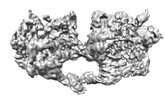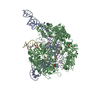+ Open data
Open data
- Basic information
Basic information
| Entry |  | |||||||||
|---|---|---|---|---|---|---|---|---|---|---|
| Title | Cryo-EM structure of spyCas9-sgRNA-DNA dimer | |||||||||
 Map data Map data | Cas9 dimer | |||||||||
 Sample Sample |
| |||||||||
 Keywords Keywords | Complex / RNA BINDING PROTEIN / RNA BINDING PROTEIN-RNA-DNA complex | |||||||||
| Function / homology |  Function and homology information Function and homology informationmaintenance of CRISPR repeat elements / 3'-5' exonuclease activity / DNA endonuclease activity / defense response to virus / Hydrolases; Acting on ester bonds / DNA binding / RNA binding / metal ion binding Similarity search - Function | |||||||||
| Biological species |  Streptococcus pyogenes (bacteria) / Streptococcus pyogenes (bacteria) /  Streptococcus pyogenes serotype M1 (bacteria) Streptococcus pyogenes serotype M1 (bacteria) | |||||||||
| Method | single particle reconstruction / cryo EM / Resolution: 5.26 Å | |||||||||
 Authors Authors | Liu J / Deng P | |||||||||
| Funding support |  China, 2 items China, 2 items
| |||||||||
 Citation Citation |  Journal: Chem Sci / Year: 2021 Journal: Chem Sci / Year: 2021Title: Nonspecific interactions between SpCas9 and dsDNA sites located downstream of the PAM mediate facilitated diffusion to accelerate target search. Authors: Mengyi Yang / Ruirui Sun / Pujuan Deng / Yuzhuo Yang / Wenjuan Wang / Jun-Jie Gogo Liu / Chunlai Chen /  Abstract: RNA-guided Cas9 (SpCas9) is a sequence-specific DNA endonuclease that works as one of the most powerful genetic editing tools. However, how Cas9 locates its target among huge amounts of dsDNAs ...RNA-guided Cas9 (SpCas9) is a sequence-specific DNA endonuclease that works as one of the most powerful genetic editing tools. However, how Cas9 locates its target among huge amounts of dsDNAs remains elusive. Here, combining biochemical and single-molecule fluorescence assays, we revealed that Cas9 uses both three-dimensional and one-dimensional diffusion to find its target with high efficiency. We further observed surprising apparent asymmetric target search regions flanking PAM sites on dsDNA under physiological salt conditions, which accelerates the target search efficiency of Cas9 by ∼10-fold. Illustrated by a cryo-EM structure of the Cas9/sgRNA/dsDNA dimer, non-specific interactions between DNA ∼8 bp downstream of the PAM site and lysines within residues 1151-1156 of Cas9, especially lys1153, are the key elements to mediate the one-dimensional diffusion of Cas9 and cause asymmetric target search regions flanking the PAM. Disrupting these non-specific interactions, such as mutating these lysines to alanines, diminishes the contribution of one-dimensional diffusion and reduces the target search rate by several times. In addition, low ionic concentrations or mutations on PAM recognition residues that modulate interactions between Cas9 and dsDNA alter apparent asymmetric target search behaviors. Together, our results reveal a unique searching mechanism of Cas9 under physiological salt conditions, and provide important guidance for both and applications of Cas9. | |||||||||
| History |
|
- Structure visualization
Structure visualization
| Supplemental images |
|---|
- Downloads & links
Downloads & links
-EMDB archive
| Map data |  emd_31721.map.gz emd_31721.map.gz | 117.4 MB |  EMDB map data format EMDB map data format | |
|---|---|---|---|---|
| Header (meta data) |  emd-31721-v30.xml emd-31721-v30.xml emd-31721.xml emd-31721.xml | 14.7 KB 14.7 KB | Display Display |  EMDB header EMDB header |
| Images |  emd_31721.png emd_31721.png | 72.3 KB | ||
| Filedesc metadata |  emd-31721.cif.gz emd-31721.cif.gz | 6.9 KB | ||
| Archive directory |  http://ftp.pdbj.org/pub/emdb/structures/EMD-31721 http://ftp.pdbj.org/pub/emdb/structures/EMD-31721 ftp://ftp.pdbj.org/pub/emdb/structures/EMD-31721 ftp://ftp.pdbj.org/pub/emdb/structures/EMD-31721 | HTTPS FTP |
-Validation report
| Summary document |  emd_31721_validation.pdf.gz emd_31721_validation.pdf.gz | 478.4 KB | Display |  EMDB validaton report EMDB validaton report |
|---|---|---|---|---|
| Full document |  emd_31721_full_validation.pdf.gz emd_31721_full_validation.pdf.gz | 478 KB | Display | |
| Data in XML |  emd_31721_validation.xml.gz emd_31721_validation.xml.gz | 6.8 KB | Display | |
| Data in CIF |  emd_31721_validation.cif.gz emd_31721_validation.cif.gz | 7.8 KB | Display | |
| Arichive directory |  https://ftp.pdbj.org/pub/emdb/validation_reports/EMD-31721 https://ftp.pdbj.org/pub/emdb/validation_reports/EMD-31721 ftp://ftp.pdbj.org/pub/emdb/validation_reports/EMD-31721 ftp://ftp.pdbj.org/pub/emdb/validation_reports/EMD-31721 | HTTPS FTP |
-Related structure data
| Related structure data |  7v59MC M: atomic model generated by this map C: citing same article ( |
|---|---|
| Similar structure data | Similarity search - Function & homology  F&H Search F&H Search |
- Links
Links
| EMDB pages |  EMDB (EBI/PDBe) / EMDB (EBI/PDBe) /  EMDataResource EMDataResource |
|---|---|
| Related items in Molecule of the Month |
- Map
Map
| File |  Download / File: emd_31721.map.gz / Format: CCP4 / Size: 125 MB / Type: IMAGE STORED AS FLOATING POINT NUMBER (4 BYTES) Download / File: emd_31721.map.gz / Format: CCP4 / Size: 125 MB / Type: IMAGE STORED AS FLOATING POINT NUMBER (4 BYTES) | ||||||||||||||||||||||||||||||||||||
|---|---|---|---|---|---|---|---|---|---|---|---|---|---|---|---|---|---|---|---|---|---|---|---|---|---|---|---|---|---|---|---|---|---|---|---|---|---|
| Annotation | Cas9 dimer | ||||||||||||||||||||||||||||||||||||
| Projections & slices | Image control
Images are generated by Spider. | ||||||||||||||||||||||||||||||||||||
| Voxel size | X=Y=Z: 1.14 Å | ||||||||||||||||||||||||||||||||||||
| Density |
| ||||||||||||||||||||||||||||||||||||
| Symmetry | Space group: 1 | ||||||||||||||||||||||||||||||||||||
| Details | EMDB XML:
|
-Supplemental data
- Sample components
Sample components
-Entire : Ternary complex of spyCas9 with sgRNA and DNA
| Entire | Name: Ternary complex of spyCas9 with sgRNA and DNA |
|---|---|
| Components |
|
-Supramolecule #1: Ternary complex of spyCas9 with sgRNA and DNA
| Supramolecule | Name: Ternary complex of spyCas9 with sgRNA and DNA / type: complex / ID: 1 / Parent: 0 / Macromolecule list: all |
|---|---|
| Source (natural) | Organism:  Streptococcus pyogenes (bacteria) Streptococcus pyogenes (bacteria) |
-Macromolecule #1: CRISPR-associated endonuclease Cas9/Csn1
| Macromolecule | Name: CRISPR-associated endonuclease Cas9/Csn1 / type: protein_or_peptide / ID: 1 / Number of copies: 2 / Enantiomer: LEVO / EC number: Hydrolases; Acting on ester bonds |
|---|---|
| Source (natural) | Organism:  Streptococcus pyogenes serotype M1 (bacteria) Streptococcus pyogenes serotype M1 (bacteria) |
| Molecular weight | Theoretical: 158.111234 KDa |
| Recombinant expression | Organism:  |
| Sequence | String: KKYSIGLDIG TNSVGWAVIT DEYKVPSKKF KVLGNTDRHS IKKNLIGALL FDSGETAEAT RLKRTARRRY TRRKNRICYL QEIFSNEMA KVDDSFFHRL EESFLVEEDK KHERHPIFGN IVDEVAYHEK YPTIYHLRKK LVDSTDKADL RLIYLALAHM I KFRGHFLI ...String: KKYSIGLDIG TNSVGWAVIT DEYKVPSKKF KVLGNTDRHS IKKNLIGALL FDSGETAEAT RLKRTARRRY TRRKNRICYL QEIFSNEMA KVDDSFFHRL EESFLVEEDK KHERHPIFGN IVDEVAYHEK YPTIYHLRKK LVDSTDKADL RLIYLALAHM I KFRGHFLI EGDLNPDNSD VDKLFIQLVQ TYNQLFEENP INASGVDAKA ILSARLSKSR RLENLIAQLP GEKKNGLFGN LI ALSLGLT PNFKSNFDLA EDAKLQLSKD TYDDDLDNLL AQIGDQYADL FLAAKNLSDA ILLSDILRVN TEITKAPLSA SMI KRYDEH HQDLTLLKAL VRQQLPEKYK EIFFDQSKNG YAGYIDGGAS QEEFYKFIKP ILEKMDGTEE LLVKLNREDL LRKQ RTFDN GSIPHQIHLG ELHAILRRQE DFYPFLKDNR EKIEKILTFR IPYYVGPLAR GNSRFAWMTR KSEETITPWN FEEVV DKGA SAQSFIERMT NFDKNLPNEK VLPKHSLLYE YFTVYNELTK VKYVTEGMRK PAFLSGEQKK AIVDLLFKTN RKVTVK QLK EDYFKKIECF DSVEISGVED RFNASLGTYH DLLKIIKDKD FLDNEENEDI LEDIVLTLTL FEDREMIEER LKTYAHL FD DKVMKQLKRR RYTGWGRLSR KLINGIRDKQ SGKTILDFLK SDGFANRNFM QLIHDDSLTF KEDIQKAQVS GQGDSLHE H IANLAGSPAI KKGILQTVKV VDELVKVMGR HKPENIVIEM ARENQTTQKG QKNSRERMKR IEEGIKELGS QILKEHPVE NTQLQNEKLY LYYLQNGRDM YVDQELDINR LSDYDVDHIV PQSFLKDDSI DNKVLTRSDK NRGKSDNVPS EEVVKKMKNY WRQLLNAKL ITQRKFDNLT KAERGGLSEL DKAGFIKRQL VETRQITKHV AQILDSRMNT KYDENDKLIR EVKVITLKSK L VSDFRKDF QFYKVREINN YHHAHDAYLN AVVGTALIKK YPKLESEFVY GDYKVYDVRK MIAKSEQEIG KATAKYFFYS NI MNFFKTE ITLANGEIRK RPLIETNGET GEIVWDKGRD FATVRKVLSM PQVNIVKKTE VQTGGFSKES ILPKRNSDKL IAR KKDWDP KKYGGFDSPT VAYSVLVVAK VEKGKSKKLK SVKELLGITI MERSSFEKNP IDFLEAKGYK EVKKDLIIKL PKYS LFELE NGRKRMLASA GELQKGNELA LPSKYVNFLY LASHYEKLKG SPEDNEQKQL FVEQHKHYLD EIIEQISEFS KRVIL ADAN LDKVLSAYNK HRDKPIREQA ENIIHLFTLT NLGAPAAFKY FDTTIDRKRY TSTKEVLDAT LIHQSITGLY ETRIDL SQ UniProtKB: CRISPR-associated endonuclease Cas9/Csn1 |
-Macromolecule #2: RNA (115-MER)
| Macromolecule | Name: RNA (115-MER) / type: rna / ID: 2 / Number of copies: 2 |
|---|---|
| Source (natural) | Organism:  Streptococcus pyogenes (bacteria) Streptococcus pyogenes (bacteria) |
| Molecular weight | Theoretical: 37.13709 KDa |
| Sequence | String: GCGCAUAAAG AUGAGACGCG UUUUAGAGCU AUGCUGUUUU GAAAAAAACA GCAUAGCAAG UUAAAAUAAG GCUAGUCCGU UAUCAACUU GAAAAAGUGG CACCGAGUCG GUGCUU |
-Macromolecule #3: DNA (49-MER)
| Macromolecule | Name: DNA (49-MER) / type: dna / ID: 3 / Number of copies: 2 / Classification: DNA |
|---|---|
| Source (natural) | Organism:  Streptococcus pyogenes (bacteria) Streptococcus pyogenes (bacteria) |
| Molecular weight | Theoretical: 15.040633 KDa |
| Sequence | String: (DA)(DT)(DG)(DA)(DG)(DA)(DC)(DG)(DC)(DT) (DG)(DG)(DC)(DG)(DA)(DT)(DT)(DA)(DG)(DC) (DT)(DA)(DA)(DT)(DC)(DG)(DC)(DC)(DA) (DG)(DC)(DG)(DT)(DC)(DT)(DC)(DA)(DT)(DC) (DT) (DT)(DT)(DA)(DT)(DG)(DC)(DG)(DC) (DC) |
-Experimental details
-Structure determination
| Method | cryo EM |
|---|---|
 Processing Processing | single particle reconstruction |
| Aggregation state | particle |
- Sample preparation
Sample preparation
| Buffer | pH: 7.5 |
|---|---|
| Vitrification | Cryogen name: ETHANE |
- Electron microscopy
Electron microscopy
| Microscope | FEI TITAN KRIOS |
|---|---|
| Image recording | Film or detector model: GATAN K3 (6k x 4k) / Average electron dose: 53.0 e/Å2 |
| Electron beam | Acceleration voltage: 300 kV / Electron source:  FIELD EMISSION GUN FIELD EMISSION GUN |
| Electron optics | Illumination mode: FLOOD BEAM / Imaging mode: BRIGHT FIELD |
| Experimental equipment |  Model: Titan Krios / Image courtesy: FEI Company |
 Movie
Movie Controller
Controller





 Z (Sec.)
Z (Sec.) Y (Row.)
Y (Row.) X (Col.)
X (Col.)





















